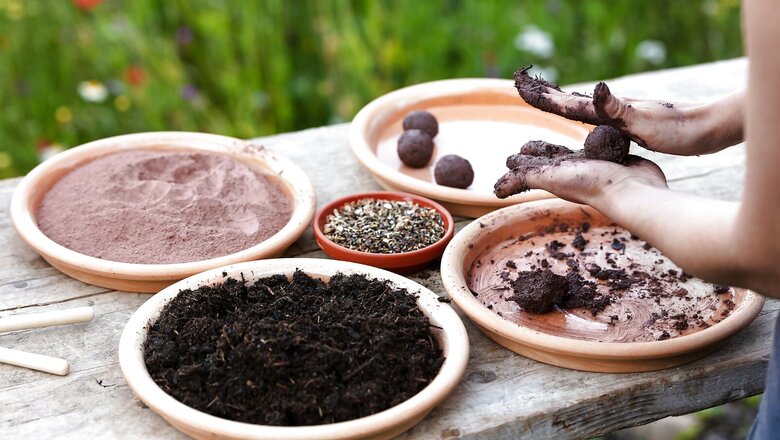
views
Have you ever wondered that 99.9 per cent of the plants on this planet grow on their own without the ‘assistance’ of human beings? The flip-side is that with the advent of human beings, more trees and plants were chopped off than they were ‘planted’. The plant kingdom is a self-sustaining and self-multiplying ecosystem. This multiplication is done by way of propagation of plants — offspring are born in the form of seeds. These seeds are carried away by birds, animals, air and water far away from the parent trees, thus bringing more areas under the tree colonies.
It will interest you more still to know that for a plant to sprout from a seed, three things are needed: seed, soil and nutrients. Seed ball is a seed wrapped in clay with some nutrients like coco peat, or moss. It is a man-made method to spread colonies of trees and plants by broadcasting seeds after giving them protection of clay and an additional dose of nutrients.
Seed balls are prepared with clay, nutrients and seeds of desired plants. Wet clay procured from riverbed is ideal which is dried in sunlight, next the seed ball material is added and given a shape of a marble. Coco peat, humus, compost or cow dung are used as nutrients which work both as perforators and water retainers. It is preferable to use a mix of different seeds in the same ball, to maximise the yield of the tree planting operation.
In humid and conducive conditions, the seed balls sprout. They are dried before they are sprinkled. They are also known as seed bombs. Unlike the traditional bombs which spread destruction, seed balls explode to spread greenery. Seed bombing is a farming technique of introducing vegetation to a land by throwing or dropping the seed balls. They are used extensively in the US, Thailand, Kenya and other African countries to grow plantation. These seed balls are air-dropped as seed bombs so as to increase the forest cover. The most recent attempt at seed bombing is by using drones to throw the seeds.
As per legends, seed balls have been part of ancient Indian traditions. Do you know how the form of Lord Jagannath was re-discovered? It was discovered through the sprouting of seed balls. As per legends, once, there lived a great devotee king Indradyumna who wished to enshrine the most splendid form of the deity in his newly constructed temple for Lord Jagannath. He sent his ministers and officials to far-off places to find out the purest form of the deity. One of his ministers named Vidyapati reached a place near modern Puri. He heard the tribals there worship a deity hidden deep in an uphill forest whose form was hailed as the most splendid in the world. Vidyapati played a game. He entrapped the daughter of the tribal chief and married her. His father-in-law agreed to show him the deity on the condition that he be blindfolded. During the journey, Vidyapati somehow was able to leave a trail by dropping mustard seeds. When they reached the secret spot of the deity, Vidyapati was stunned by the never-before-seen beauty, aura and sanctity of the deity. No sooner did Vidyapati return after a glimpse of the deity, he left the village to report to king Indradyumna. The king’s men could reach the spot where the deity was located by following the trail of the now-germinated mustard flowers. However, the king could not find the deity! This shows seeds can be used by humans to germinate plants.
How to Make Seed Balls
– Take some clay, seeds, compost and moss. Now, mix equal proportions of red clay soil, black soil and compost. Add 1 to 2 parts water slowly until you get thick, dough-like consistency. Put the seed you have chosen at the centre (maximum of three seeds). Once you have placed your seed, roll the portion of dough between your hands into a marble-sized seed ball. Let them dry for 24-48 hours until they are fully dry. The dried clay protects the seed from seed predators (ants, mice and birds) as well as from rupture. Once sufficient rain permeates the clay, the seeds inside begin to germinate, helped along by the nutrition and minerals (humus) contained within the balls. Seed balls should be scattered on the ground and forgotten about. They will sprout when there is enough rain. There is no need to plant them, as they are already surrounded by soil, nutrients and microorganisms.
When and What Kind of Seeds Should be Used?
Generally seeds of native plants or trees should be used. They have a better chance of survival and sprouting. The best time for sprinkling the seed balls is the rainy season, when there is higher chance of sprouting.
Benefits of Seed Ball:
– Seed balls help increase green space. They can work well anywhere in any season but the most productive season is the rainy season. Seed balls have an 80 per cent growth success rate compared to regular seedlings.
– They reduce the labour of ploughing or digging holes for seeds.
– They can be thrown in inaccessible places like hills, steep slopes, barren lands, watersheds, remote areas etc,. and help in reclaiming derelict ground.
– They can be simply scattered directly on the ground and do not require to be conventionally planted.
– They remain healthy for years and are protected from wind, birds, squirrels and other critters.
– Seed balls are useful for seeding in dry, thin and compacted soils.
– They are easy to use and huge and inaccessible areas can be covered in a short span of time.
– Seed-balls are affordable, sustainable and an effective conservation tool for establishing vegetation in difficult areas.
– Seed balls are particularly useful in dry and arid areas where rainfall is scanty and highly unpredictable.
Recently, the Prime Minister at the drone festival emphasised the use of drone technology in dropping the seed balls, highlighting the importance of both the seed balls and the technology to spread it.
Geetanjali Mehra is an interior designer by profession. She has co-authored the book, ‘Gift Lungs to Future Generations’. The views expressed in this article are those of the author and do not represent the stand of this publication.
Read all the Latest Opinions here

















Comments
0 comment